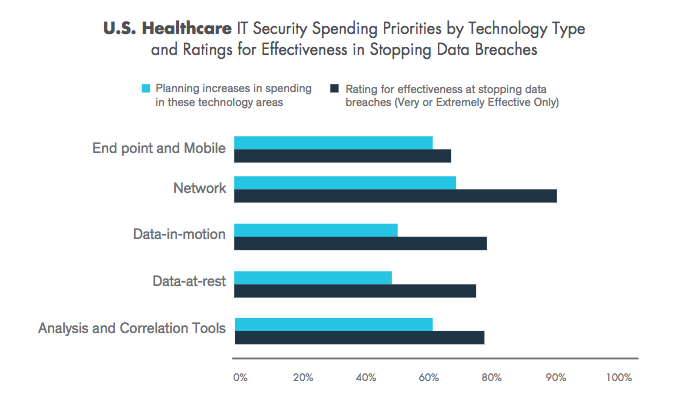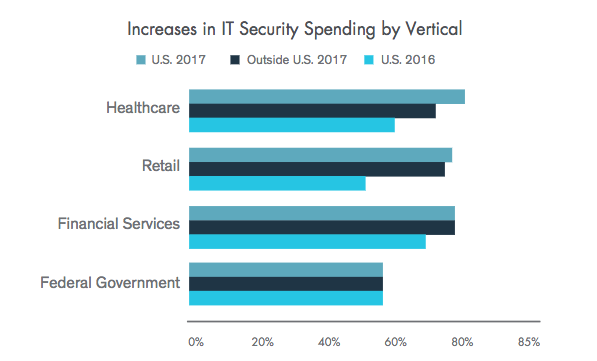
Credit: 2017 Thales Data Threat Report
Cybersecurity spending will increase at the vast majority of healthcare organizations in 2017, according to a new report.
Eighty-one percent of U.S. healthcare organizations plan to increase data security spending in 2017, according to the 2017 Thales Data Threat report, which polled 1,100 IT security executives. That’s more than any other industry.
As new technologies come into the fold and regulations push healthcare organizations to digitize data in the name of efficiency, that data becomes more vulnerable as access points increase.
From Thales:
In this age of the cloud and SaaS enterprise deployments, more and more enterprise data is being created, transported, processed and stored outside corporate network boundaries, making traditional perimeter-based security controls and legacy network and endpoint protection solutions increasingly less relevant. Other new, popular technologies also bring added security challenges. For example, nearly 40 percent of respondents are using Docker containers for production applications. At the same time, 47 percent cite security as the ‘top barrier’ to broader Docker container adoption.
Peter Galvin, vice president of strategy, Thales e-Security says:
“Enterprises today must inevitably confront an increasingly complicated threat landscape. Our world, which now includes the cloud, big data, the IoT and Docker, calls for robust IT security strategies that protect data in all its forms, at rest, in motion and in use. Businesses need to invest in privacy-by-design defense mechanisms – such as encryption – to protect valuable data and intellectual property and view security as a business enabler that facilitates digital initiatives and builds trust between partners and customers.”
In the United States in particular, compliance was a driving force behind spending increases. That wasn’t the case for overseas organizations.
From Thales:
The reasons behind security spending decisions are varied, but the key driver remains constant: compliance. Almost half (44 percent) of respondents list meeting compliance requirements as their top spending priority, followed by best practices (38 percent) and protecting reputation/brand (36 percent). Fifty-nine percent also believe compliance is ‘very’ or ‘extremely’ effective at preventing data breaches. While compliance regulations provide a data security blueprint, they are by no means the only consideration when building a security strategy robust enough to withstand today’s sophisticated attackers.
The report ends with several recommendations:
To offset the data breach trend and take advantage of new technologies and innovations, at minimum organizations should adhere to the following practices:
*Leverage encryption and access controls as a primary defense for data and consider an ‘encrypt everything’ strategy
*Select data security platform offerings that address a variety of use cases and emphasize ease-of-use
*Implement security analytics and multi-factor authentication solutions to help identify threatening patterns of data use.


